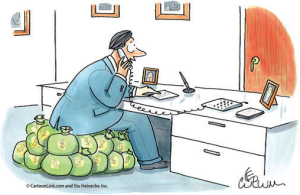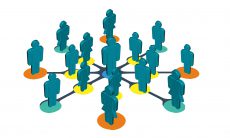First a disclaimer – I’m an “old” salesperson! Old in the number of years on planet earth–and also old as in years ago, I began my career in the chemical and plastics industry selling and managing salespeople. I have a salesperson’s perspective in B2B, and I still consider myself a salesperson even though I have been on the marketing side since the early 1980’s.
I’m bothered by much of what I read and hear today when marketing people and agencies pontificate about B2B in presentations, webinars, white papers, and even blogs like Biznology. In response, for this blog, I’m taking the mantel of “curmudgeon,” and am going to spout off on five currently held beliefs and trends.
Here are my top five beliefs and/or trends that seem wrong or wrongheaded, and need someone to shine the light of day on them.
- B2B is a market
The definition of business-to-business is and never was meant to be a description of a market, but rather the type of organization that is sold to by a company vs. consumer, government or institution. We all know this, and yet I read articles, white papers, and hear presentations (the recent BMA Conference is an example), where B2B is referred to as if it was a homogeneous market.
The reality is that B2B is composed of hundreds, if not several thousand, vertical and horizontal markets having quite different profiles and buying characteristics. Why am I pointing out the obvious? Simply because the marketing strategies, tactics and solutions so proudly promoted in B2B don’t work across these multiple markets in the same way. That’s why market segmentation is the first process needed, and is so critical to achieve marketing and sales success. (Request our 15 page white paper titled B2B Profiling, Targeting & Segmentation to learn more about segmentation for B2B)
- 60% of the buying process is completed before contact with vendors
Baloney! As with many things in B2B – it depends. If the purchase is for ad specialties it might be 80-90% before a phone call is made. With machine tools it is probably close to 10%, as this is a very complex high value sale and no website can begin to address the buying questions and customization needed.
Also, the B2B purchasing process is not binary – first online and then offline. It bounces back and forth between online and offline. Whether it’s a visit to the booth at a trade show, live seminars, or even a phone call to the company, the offline human element is still critical to the buying process, and not just at the end. While I didn’t attend the Sirius Decisions conference this year, I have read they presented some research along these lines. Yay for Sirius and their smart people!
The other bone I have to pick with this widely bantered number is, did it all of a sudden go from 0 to 60%? Where are the studies that not only back up this claim, but also how did it evolve?
- B2B buyers buy on price, quality, service and delivery
No debate that these four aspects of the value proposition are important, but they hide or under-emphasize probably the two most important elements a B2B buyer is looking for when making an important high value purchase: relationship and trust.
I’m not going to dive into the psychology of the buyer, but I would point out that #1 reason purchases are not made is the perceived degree of risk undertaken. Risk to the company and, more importantly, risk to the individual who is making the decision in regard to their job performance and potential. We sell to people, not companies, and when we forget that, there is a good chance of either getting beaten by competitors or losing the sale to the famous “no decision.” To be successful in B2B, you must deal with the emotional side of the buyer’s mindset, build a relationship, and reduce risk.
- Outbound marketing is out
This is one of my favorite bones to pick with digital marketing experts! It’s not that inbound marketing is not important; it’s just that if you have a highly targetable and valuable market, you can’t rely only on inbound marketing to enough generate leads. This is true for most B2B companies. You must target the potential firms and individuals who can or should purchase your product or service and go get them. Sales people do this as part of their DNA, and marketers need to think more like sales people to bridge the gap between marketing and sales. The key question to answer for any targeted market is what is the balance between outbound and inbound? Each market may be different.
- Direct mail is dead
Not only is it not dead, it’s making a comeback. I’ve met with a number of B2B clients and service providers, and found that direct mail is not only producing good response rates, but also the leads generated convert at a higher rate. This is particularly true for impact mailers, as breaking through the clutter today is harder than ever.
Here’s a great example of an impact mailing that got both high response and conversion rates.
Cartoonist Stu Heinecke (www.cartoonlink.com) produces a number of great cartoons where the caption can be personalized. Here is one that we used for a client and did the following:
- Personalized it with the name of the contact we were trying to reach after first verifying with a phone call to insure accuracy. (I used my name for this example)
- Put the cartoon in a frame suitable for either desk or wall display
- Wrote a cover letter that tied the cartoon into the value proposition of the software
- Sent the package overnight mail
- Followed up with a phone call no later than 2 days following receipt of the package
“I’m sitting of piles of cash since I listened to John Coe.”
As mentioned, results were outstanding, but that’s not my point. This is an example that mail is not dead in B2B; it just has to be used properly. Other examples of direct mail continue to prove its value vs. email.
Summary:
There are at least another five trends or beliefs that can be debunked – maybe another blog.







